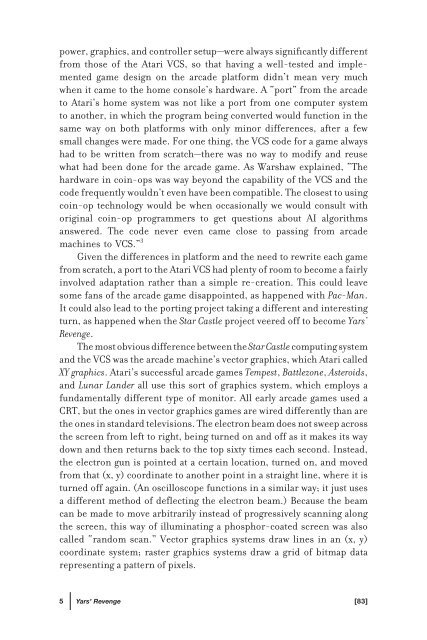Racing the Beam : the Atari Video Computer System - Index of
Racing the Beam : the Atari Video Computer System - Index of
Racing the Beam : the Atari Video Computer System - Index of
Create successful ePaper yourself
Turn your PDF publications into a flip-book with our unique Google optimized e-Paper software.
power, graphics, and controller setup—were always signifi cantly different<br />
from those <strong>of</strong> <strong>the</strong> <strong>Atari</strong> VCS, so that having a well-tested and implemented<br />
game design on <strong>the</strong> arcade platform didn’t mean very much<br />
when it came to <strong>the</strong> home console’s hardware. A “port” from <strong>the</strong> arcade<br />
to <strong>Atari</strong>’s home system was not like a port from one computer system<br />
to ano<strong>the</strong>r, in which <strong>the</strong> program being converted would function in <strong>the</strong><br />
same way on both platforms with only minor differences, after a few<br />
small changes were made. For one thing, <strong>the</strong> VCS code for a game always<br />
had to be written from scratch—<strong>the</strong>re was no way to modify and reuse<br />
what had been done for <strong>the</strong> arcade game. As Warshaw explained, “The<br />
hardware in coin-ops was way beyond <strong>the</strong> capability <strong>of</strong> <strong>the</strong> VCS and <strong>the</strong><br />
code frequently wouldn’t even have been compatible. The closest to using<br />
coin-op technology would be when occasionally we would consult with<br />
original coin-op programmers to get questions about AI algorithms<br />
answered. The code never even came close to passing from arcade<br />
machines to VCS.” 3<br />
Given <strong>the</strong> differences in platform and <strong>the</strong> need to rewrite each game<br />
from scratch, a port to <strong>the</strong> <strong>Atari</strong> VCS had plenty <strong>of</strong> room to become a fairly<br />
involved adaptation ra<strong>the</strong>r than a simple re-creation. This could leave<br />
some fans <strong>of</strong> <strong>the</strong> arcade game disappointed, as happened with Pac-Man.<br />
It could also lead to <strong>the</strong> porting project taking a different and interesting<br />
turn, as happened when <strong>the</strong> Star Castle project veered <strong>of</strong>f to become Yars’<br />
Revenge.<br />
The most obvious difference between <strong>the</strong> Star Castle computing system<br />
and <strong>the</strong> VCS was <strong>the</strong> arcade machine’s vector graphics, which <strong>Atari</strong> called<br />
XY graphics. <strong>Atari</strong>’s successful arcade games Tempest, Battlezone, Asteroids,<br />
and Lunar Lander all use this sort <strong>of</strong> graphics system, which employs a<br />
fundamentally different type <strong>of</strong> monitor. All early arcade games used a<br />
CRT, but <strong>the</strong> ones in vector graphics games are wired differently than are<br />
<strong>the</strong> ones in standard televisions. The electron beam does not sweep across<br />
<strong>the</strong> screen from left to right, being turned on and <strong>of</strong>f as it makes its way<br />
down and <strong>the</strong>n returns back to <strong>the</strong> top sixty times each second. Instead,<br />
<strong>the</strong> electron gun is pointed at a certain location, turned on, and moved<br />
from that (x, y) coordinate to ano<strong>the</strong>r point in a straight line, where it is<br />
turned <strong>of</strong>f again. (An oscilloscope functions in a similar way; it just uses<br />
a different method <strong>of</strong> defl ecting <strong>the</strong> electron beam.) Because <strong>the</strong> beam<br />
can be made to move arbitrarily instead <strong>of</strong> progressively scanning along<br />
<strong>the</strong> screen, this way <strong>of</strong> illuminating a phosphor-coated screen was also<br />
called “random scan.” Vector graphics systems draw lines in an (x, y)<br />
coordinate system; raster graphics systems draw a grid <strong>of</strong> bitmap data<br />
representing a pattern <strong>of</strong> pixels.<br />
5 Yars’ Revenge [83]


